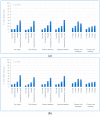Association of Organizational Behavior with Work Engagement and Work-Home Conflicts of Physician in China
- PMID: 34069341
- PMCID: PMC8158697
- DOI: 10.3390/ijerph18105405
Association of Organizational Behavior with Work Engagement and Work-Home Conflicts of Physician in China
Abstract
This study aimed to examine how organizational behavior is associated with work engagement (WE) and work-home conflicts (WHCs) of physicians. The data were from a national cross-sectional survey of 3255 Chinese physicians. We examined organizational fairness, leadership attention, and team interaction for organizational behavior. The results indicate that greater organizational fairness is associated with higher WE and lower WHCs. High task fairness was associated with greater pride, and more enjoyment in work, lower sense of guilt towards their family, and less complaints from family members. Physicians reporting higher levels of leaders' attention to their opinions reported experiencing more enjoyment of their work, and less effects on their care for family. A greater number of dinners with colleagues per month was associated with higher WE and lower WHCs, whilst a greater number of clinical case meetings per month was associated with higher WE and higher WHCs. The results suggest that the behavior of organizations could be an important intervention to improve the wellbeing of physicians.
Keywords: organizational behavior; physician; work engagement; work-home conflicts.
Conflict of interest statement
The authors have declared that no competing interests exist.
Figures



Similar articles
-
Association of organizational and patient behaviors with physician well-being: A national survey in China.PLoS One. 2022 May 31;17(5):e0268274. doi: 10.1371/journal.pone.0268274. eCollection 2022. PLoS One. 2022. PMID: 35639674 Free PMC article.
-
The home care work environment's relationships with work engagement and burnout: A cross-sectional multi-centre study in Switzerland.Health Soc Care Community. 2020 Nov;28(6):1989-2003. doi: 10.1111/hsc.13010. Epub 2020 May 4. Health Soc Care Community. 2020. PMID: 32364334
-
The mediating role of inclusive leadership: Work engagement and innovative behaviour among Chinese head nurses.J Nurs Manag. 2019 May;27(4):688-696. doi: 10.1111/jonm.12754. Epub 2019 Apr 9. J Nurs Manag. 2019. PMID: 30702790
-
Executive Leadership and Physician Well-being: Nine Organizational Strategies to Promote Engagement and Reduce Burnout.Mayo Clin Proc. 2017 Jan;92(1):129-146. doi: 10.1016/j.mayocp.2016.10.004. Epub 2016 Nov 18. Mayo Clin Proc. 2017. PMID: 27871627 Review.
-
Physician engagement: the Vancouver Medical Staff Association engagement charter.Clin Med (Lond). 2019 Jul;19(4):278-281. doi: 10.7861/clinmedicine.19-4-278. Clin Med (Lond). 2019. PMID: 31308103 Free PMC article. Review.
Cited by
-
Work-Family Guilt in Spanish Parents: Analysis of the Measurement, Antecedents and Outcomes from a Gender Perspective.Int J Environ Res Public Health. 2021 Aug 3;18(15):8229. doi: 10.3390/ijerph18158229. Int J Environ Res Public Health. 2021. PMID: 34360524 Free PMC article.
-
The influence of distributive justice on job attitudes and life satisfaction of hotel workers.Heliyon. 2024 Feb 9;10(4):e25961. doi: 10.1016/j.heliyon.2024.e25961. eCollection 2024 Feb 29. Heliyon. 2024. PMID: 38380037 Free PMC article.
-
Beyond the walls of the classroom: the psychodynamics of professional commitment and job involvement among female primary school teachers.Front Psychol. 2024 Oct 18;15:1465880. doi: 10.3389/fpsyg.2024.1465880. eCollection 2024. Front Psychol. 2024. PMID: 39492808 Free PMC article.
-
Association of Hospital Characteristics and Previous Hospitalization-Related Experiences with Patients' Perceptions of Hospital Care in China.Int J Environ Res Public Health. 2022 Jun 27;19(13):7856. doi: 10.3390/ijerph19137856. Int J Environ Res Public Health. 2022. PMID: 35805515 Free PMC article.
References
-
- Upadyaya K., Vartiainen M., Salmela-Aro K. From job demands and resources to work engagement, burnout, life satisfaction, depressive symptoms, and occupational health. J. Burn. 2016;3:101–108. doi: 10.1016/j.burn.2016.10.001. - DOI
Publication types
MeSH terms
LinkOut - more resources
Full Text Sources

